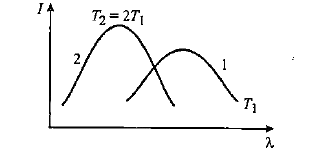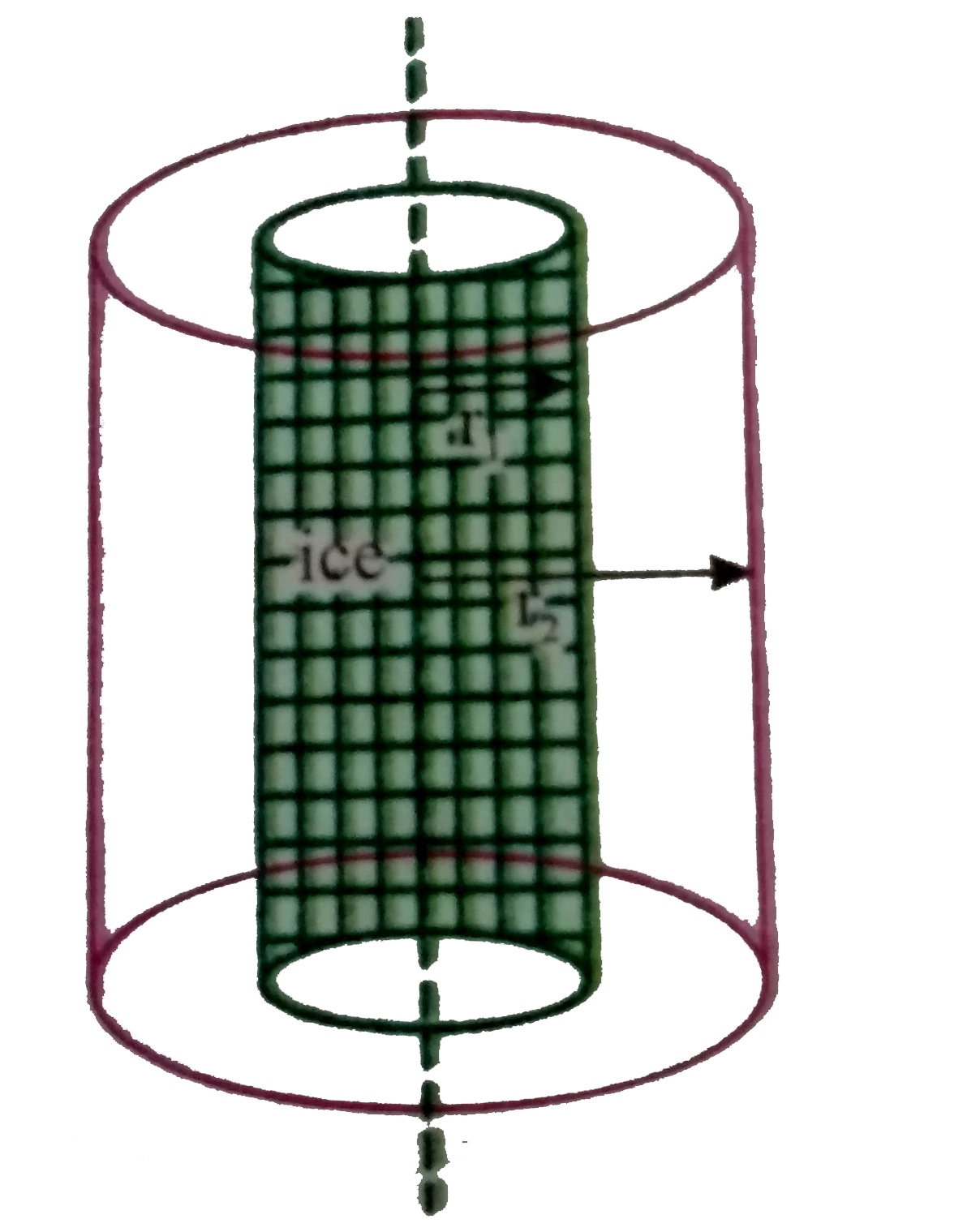Complete Solutions to Advance MCQs with One or More Option Correct of chapter HEAT TRANSFER of Class 12 book with complete answers and questions
| Class 12 | PHYSICS |
| Chapter | HEAT TRANSFER |
| PHYSICS GALAXY | Advance MCQs with One or More Option Correct |
| Number Of Questions | 20 |
| Academic Year | 2023-24 |
An insulated container is filled with ice at `0^(@)C,` and another container is filled with water that is continuously boiling at `100^(@)C.` In series of experiments, the container connected by various, thick metal rods that pass through the walls of container as shown in the figure-4.46.
In the experiment- I: A copper rod is used and all ice melts is 20 minutes.
In the experiment - II: A steel rod of identical dimensions is used and all melts in 80 minutes.
In the experiment-III: Both the are used in parallel all ice melts in `t_(10)` minutes.
In the cxperiment-IV: Both rods are used in parallel all ice melts in `t_(20)`

View SolutionTwo spheres A and B have radius but the heat capacity of A is greater than that of B. The surfaces of both are painted black. They are heated to the same temperature and allowed to cool. Then initially
View SolutionThe two ends of a uniform rod of thermal conductivity k are maintained at different but constant temperatures. The temperature gradientat any point on the rod is `(d theta)/(dl)`(equal to the difference in temperature per unit length). The heat flow per unit time per unit cross-section of the rod is `l` then which of the following statements is/are correct:
View SolutionA planet having surface temperature T, K has a solar constant S. An angle `theta` is subtended by the sun at the planet:
View SolutionTwo ends of area A of a uniform rod of thermal conductivity k are maintained at different but constant temperatures. At any point on the rod, the temperature gradient is `(dT)/(dl)`. If I be the thermal current in the rod, then:
View SolutionTwo bodies A and B have thermal emissivities of 0.01 and 0.81 respectively. The outer surface areas of the two bodies are same. The two bodies emit total radiant power at the same rate. The wavelength `lambda_B` corresponding to maximum spectral radiancy from B is shifted from the wavelength corresponding to maximum spectral radiancy in the radiation from A by 1.0 `mum`. If the temperature of A is 5802 K, calculate (a) the temperature of B, (b) wavelength `lambda_B`.
View SolutionCurved surface of a uniform rod is isolated from surrounding. Ends of the rod are maintained at temperatures `T_(1)` and `T_(2)(T_(1)>T_(2))` for a long time. At an instant, temperature `T_(1)` starts to decrease at a constant and slow rate. If thermal capacity of material of the rod is considered, then which of thefollowing statements is/are correct ?
View SolutionA thin spherical shell and a thin cylindrical shell (closed at both ends) have same volume. Both the shells are filled with water at the same temperature and are exposed to the same atmosphere. Initial temperature of water is slightly greater than that of surrounding. Then at initial moment:
View SolutionThe gross radiation emitted by a perfectly black body is:
View SolutionThe rates of fall temperature of two identical solid spheres of different materials are equal at a certain temperature if:
View SolutionA hollow copper sphere & a hollow copper cube of same surface area & negligible thickness , are filled with warm water of same temperature and placed in an enclosure of constant temperature a few degrees below that of the bodies. Then in the beginning:-
View SolutionThe plots of intensity vs wavelength for two black bodies at temperature `T_(1)` and `T_(2)` such that `T_(2) = 2T_(1)`, respectively are as shown. Let the energy radiated per second by body I and body 2 be `E_(1)` and `E_(2)` respectively. Pick up the correct statement(s).

View SolutionA metal cylinder of mass `0.5` kg is heated electrically by a 12 W heater in a room at `15^(@)` C. The cylinder temperature rises uniformly to `25^(@)` C in 5 min and finally becomes constant at `45^(@)` C Assuming that the rate of heat losss is proportional to the excees temperature over the surroundings,
View SolutionA particle of mass 1 kg slides in a horizontal circle of radius 20 m with a constant speed of `1 m//s.` The only forces in the vertical direction acting on the particle are its weight and the normal reaction, however no information is available about the forces in the horizontal plane. Over a period of time whole energy dissipated due to work done by friction is conducted to ground and simultaneously radiated to surround. If the coefficient of friction is `mu =0.5.` Then (Take `g =10 m//s^(2):
View SolutionIn accordance with Kirchhoffs law (Assume transmissivity `a_(t)arrow 0` for all the cases):
View SolutionA hollow and a solid sphere of same material and identical outer surface under identical condition are heated to the same temperature at the same time (both have same e, a):
View SolutionA heated body emits radiation which has maximum intensity at frequency `v_m` If the temperature of the body is doubled:
View SolutionTwo spherical black bodies A and B,having radii `r_(A)` and `r_(B) =2r_(A)` emit radiation with peak intensities at wavelength 400 nm and 800 nm respectively. If their temperature are `T_(A)` and `T_(B)` respectively in Kelvin scale, their emissive powers are `E_(A)` and `E_(B)` then :
View SolutionWhich of the following statements are true?
View SolutionA `100 cm` long cylindrical flask with inner and outer diameter `2 cm` and `4cm` respectively is completely filled with ice as shown in the The constant temperature outside the flask is `40^(@)C`
(Thermal conductivity of the flask is `0.693 W// m^(@)C, L_(ice) = 80cal// gm & In 2=0.693)`

View Solution
Advance MCQs with One or More Option Correct questions and complete solutions for chapter HEAT TRANSFER of GK PUBLICATIONS PHYSICS (HINGLISH) of Class 12
All Exercises from PHYSICS GALAXY Class 12 PHYSICS HEAT TRANSFER
- Advance MCQs with One or More Option Correct
- Conceptual MCQs Single Option Correct
- Discussion Question
- Illustrative Example 4.1
- Illustrative Example 4.10
- Illustrative Example 4.11
- Illustrative Example 4.12
- Illustrative Example 4.13
- Illustrative Example 4.14
- Illustrative Example 4.15
- Illustrative Example 4.16
- Illustrative Example 4.17
- Illustrative Example 4.18
- Illustrative Example 4.19
- Illustrative Example 4.2
- Illustrative Example 4.20
- Illustrative Example 4.21
- Illustrative Example 4.22
- Illustrative Example 4.23
- Illustrative Example 4.24
- Illustrative Example 4.25
- Illustrative Example 4.26
- Illustrative Example 4.27
- Illustrative Example 4.28
- Illustrative Example 4.29
- Illustrative Example 4.3
- Illustrative Example 4.4
- Illustrative Example 4.5
- Illustrative Example 4.6
- Illustrative Example 4.7
- Illustrative Example 4.8
- Illustrative Example 4.9
- Numerical MCQs Single Options Correct
- Practice Exercise 4.1
- Practice Exercise 4.2
- Practice Exercise 4.3
- Practice Exercise 4.4
- Unsolved Numerical Problems for Preparation of NSEP,INPhO&IPhO